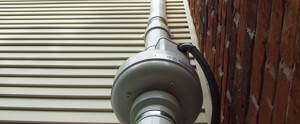Today Show Report: Is your Child Breathing Radon Gas at School?
What experts call a serious threat in our nation's schools is invisible to the naked eye. TODAY National Investigative Correspondent Jeff Rossen reports.
When we send our children to school, we assume that they're safe; that they're learning in a healthy environment. But health officials say there's a danger in the air: a toxic cancer causing gas in thousands of classrooms nationwide. And, we found, many districts are doing nothing about it.
We visited a school in Pennsylvania and found second-graders are ready to learn. But what the kids can't see, smell or taste are high levels of radioactive radon gas inside their classrooms. Tests show nearly double the EPA's accepted limit.
Radon develops from the breakdown of soil and rock, seeping into buildings and the air we breathe. Chronic exposure, experts say, could be deadly. And perhaps most disturbing, victims usually don't realize they have been exposed until years later, when it's too late.
Next to smoking, it is the leading cause of lung cancer -- according to the EPA, linked to more than 20,000 deaths every year. "Of all the environmental exposures you get, this is the one that causes the most deaths," said Bill Field, one of the foremost experts on radon.
"If you had to compare radon exposure to smoking, what are these children being exposed to?" we asked him.
"Well, if a student's exposed, even at the EPA's action level, 4 picocuries per liter, that's equivalent to smoking half a pack of cigarettes per day," Field said.
Gail Orcutt is a retired teacher in Iowa. When she started coughing, she went to the doctor. "He said, 'You have a nodule on your left lung, and it's probably malignant,'" she told us. "Lung cancer."
"Had you smoked a day in your life?" we asked.
"Never a day in my life, no."
On a hunch, Gail tested her house for radon and, sure enough, the levels were high. Doctors told her that's the likely cause.
"The doctor removed my entire left lung," she said. "And then I went through 12 weeks of chemo."
Turns out Gail's home, the schools where she taught, and in fact the entire state of Iowa are in what the EPA calls a level 1 radon hot zone. I asked her whether the elementary school where she taught for years was ever tested for radon. "No, and I always kind of wondered if I was exposed here as well as my home," she said.
Most schools don't test. Experts say districts can't afford it, even though the EPA estimates that more than 70,000 classrooms nationwide are at risk. Believe it or not, only five states require testing. And there's no federal law mandating it.
"Sometimes money has a much more powerful influence than people's health," Bill Field said.
So we had an idea: Working with a certified lab, NBC News contacted 40 school districts nationwide, all in radon hot zones. We offered to pay for their radon testing. But all 40 declined our offer -- or didn't respond at all. Some said "the science isn't there"; others didn't give a reason.
In Indianapolis, school administrators originally said, "Yes, test three of our schools." They even gave us their floor plans so our lab could figure out where to place the radon detectors. But the district suddenly pulled out, with one official telling us: "This can only make us look bad. If the levels are high, parents will get upset and want every school tested."
"Why would they decline it if it's free?" parent Randy Gross asked. I mean, if it is a free service, I would take it." So we followed up with school officials. All the districts declined to be interviewed, too.
The thing is, when schools do test, it can save lives. In Connecticut, one of the states where it's mandatory, one district got a wake-up call. Principal Jason MacKinnon took us into Branchville Elementary School: "This kindergarten classroom where we have 5- and 6-year-olds, the results were alarming," he said.
Four hundred classrooms throughout Connecticut tested high. They've all been fixed with new pipes for ventilation. And remember those second-graders in Pennsylvania sitting in classrooms with elevated levels of the toxic gas? Administrators were proactive.
"I think it is imperative that we find out what the situation is and if there is a problem, take care of it," said David Baugh, superintendent, Bensalem Township School District. They tested nine schools voluntarily. In one of them, 15 classrooms came in high. School officials are planning to fix it.
So why not make all schools test? Once upon a time the government seemed focused on it. There was lots of press about radon, and Congress even held a hearing in 1993. "Congress was told 20 years ago there was a problem," expert Bill Field said.
"And what have they done?" we asked.
"Nothing."
We contacted the lead members of the environmental committees, requesting on-camera interviews. They all declined. One blamed the EPA. Another said it is a state issue. Which means kids continue breating radon's toxis fumes, and parents can't do a thing about it.




